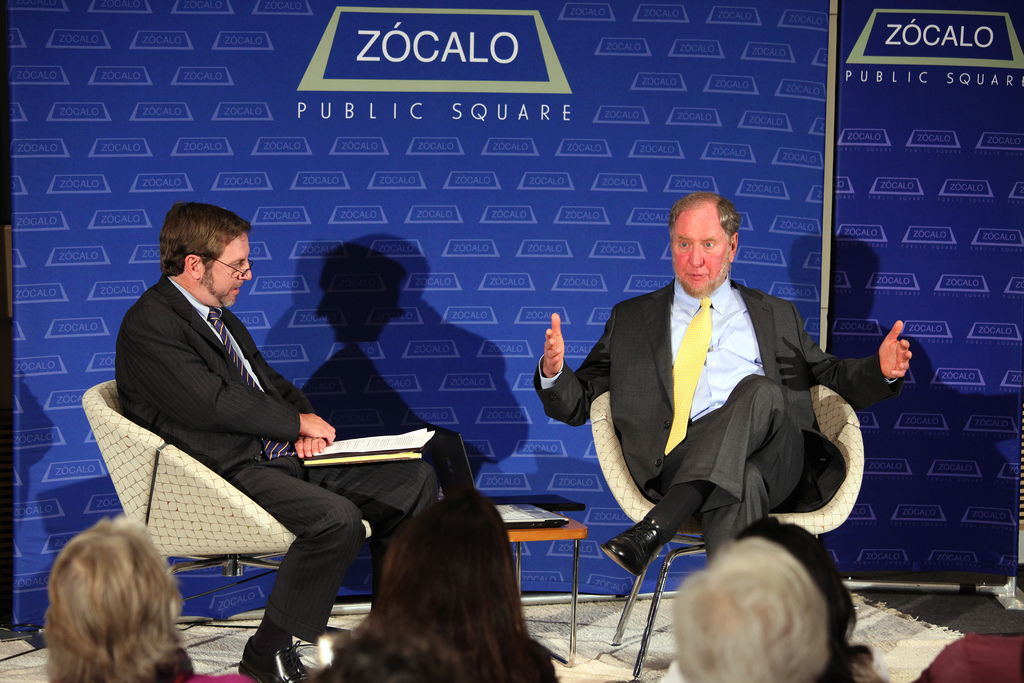
The recent uproar over building a mosque and community center near Ground Zero illustrated an interesting paradox about religion in America.
“America is very religiously devout and religiously diverse,” said Robert Putnam, the groundbreaking political scientist and author of American Grace: How Religion Divides and Unites Us. “In most places in the world, that combination produces mayhem – Belfast, Bosnia, Beirut, Baghdad, Bombay.”
But the U.S. is, he said, “surprisingly tolerant across racial lines.”
In an event co-presented with the UCLA School of Public Affairs’ Center for Civil Society, Putnam joined UCLA’s Bill Parent to talk about how religion in America has radically changed over the last 50 years, creating a country at once quite divided and quite tolerant.
One hour on Sunday to co-ed dorms
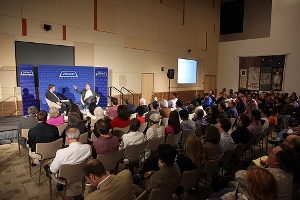 In the 1950s, Putnam said, America was probably more religiously observant than ever in the nation’s history, at least until the “lightning bolt” of the 1960s. As Americans challenged authority on every front – the anti-Vietnam protests, the Civil Rights movement, feminism – mores changed rapidly. The number of Americans who thought premarital sex was acceptable doubled in four years, with a huge generational difference between baby boomers and their predecessors.
In the 1950s, Putnam said, America was probably more religiously observant than ever in the nation’s history, at least until the “lightning bolt” of the 1960s. As Americans challenged authority on every front – the anti-Vietnam protests, the Civil Rights movement, feminism – mores changed rapidly. The number of Americans who thought premarital sex was acceptable doubled in four years, with a huge generational difference between baby boomers and their predecessors.
“When I was in college,” said Putnam, who graduated in 1963, “men and women were not allowed to be in the same room ever except between three and four on Sunday afternoon, with the door open and three feet on the floor. Three years later, the same college had co-ed dorms and co-ed rooms.”
He joked, “All over America there were a group of men exactly my age who thought, shucks, if only I’d been born three years later.”
These decades saw a drastic transformation of the Catholic Church – as those of Southern and Eastern European descent left the church, Latinos came in, bringing with them socially conservative views. But in general, the country moved in a secular direction. Those who were alarmed by that trend, Putnam said, produced an “aftershock,” moving to the most religious end of the spectrum and creating what would come to be known as the Religious Right.
“It did not begin as a political movement, but politicians quickly saw they were there,” Putnam said.
The geography of religion also transformed, Putnam noted in Q&A. Previously, it declined “with a square of the distance to the Mississippi River” – the further away from the big river, the less religious Americans were. Religion came to be concentrated in the South after the 1960s, largely because of politics.
Save your soul, or vote for Bill
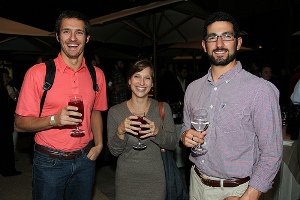 That shift prompted another, Putnam explained. Young people – those now in their 20s and early 30s – saw religion as essentially conservative and espousing intolerance. They believed, as Putnam explained, “If that’s all religion is, I’m outta here.” They became what Putnam calls the “young nones.” They aren’t necessarily atheistic or anti-religion, but they’re turned off by organized religion, and their movement toward secularism emptied out the moderate, apolitical religious center. The most visible religious leadership, Putnam said, jagged to the right at the same time. It’s unusual for a nation in which most progressive change – from independence and abolition to Civil Rights – was driven by religion. (The exception to this trend is African Americans, Putnam noted in Q&A, who remain devout and progressive, and accepting of Muslims, owing to the large number of black Muslims.)
That shift prompted another, Putnam explained. Young people – those now in their 20s and early 30s – saw religion as essentially conservative and espousing intolerance. They believed, as Putnam explained, “If that’s all religion is, I’m outta here.” They became what Putnam calls the “young nones.” They aren’t necessarily atheistic or anti-religion, but they’re turned off by organized religion, and their movement toward secularism emptied out the moderate, apolitical religious center. The most visible religious leadership, Putnam said, jagged to the right at the same time. It’s unusual for a nation in which most progressive change – from independence and abolition to Civil Rights – was driven by religion. (The exception to this trend is African Americans, Putnam noted in Q&A, who remain devout and progressive, and accepting of Muslims, owing to the large number of black Muslims.)
And, Putnam noted, most people adapted their religious beliefs to fit their politics rather than vice versa. “I could not believe people would be hazarding their eternal souls over Bill Clinton or George Bush,” he said.
But despite the trend, Putnam said, the young nones may not be a lasting phenomenon. “American religious leaders are endlessly inventive,” Putnam said. “Jesus said to his disciples, be fishers of men. There is a pool with lots of fish and no anglers. Over the next 10 or 15 years, some religious anglers will be trying different lures in that pond. Some will be failures but some will be successes. Twenty years from now our religious landscape will change again – that would be perfectly consistent with American history.”
Chelsea Clinton and Aunt Susan
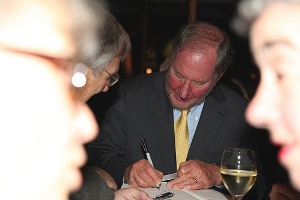 Despite the divides, and the hollowing out of the religious middle, Putnam noted that interfaith tolerance is on the rise. Few Americans today are “true believers” – that is, few believe either that all religion is wrong, or that only one religion is the true faith. Even most evangelical protestants fall into a middle category of people, Putnam said, who accept that all religions have aspects of truth to them. Most Americans who believe in heaven, he continued, even think that people of different faiths can make it. “We thought, maybe that’s just Methodists saying a few Lutherans are going to get in,” Putnam said. “But the overwhelming majority of Christian Americans say you don’t have to be Christian to get into heaven.”
Despite the divides, and the hollowing out of the religious middle, Putnam noted that interfaith tolerance is on the rise. Few Americans today are “true believers” – that is, few believe either that all religion is wrong, or that only one religion is the true faith. Even most evangelical protestants fall into a middle category of people, Putnam said, who accept that all religions have aspects of truth to them. Most Americans who believe in heaven, he continued, even think that people of different faiths can make it. “We thought, maybe that’s just Methodists saying a few Lutherans are going to get in,” Putnam said. “But the overwhelming majority of Christian Americans say you don’t have to be Christian to get into heaven.”
The explanation, he said, may lie in the fact that we have closer personal ties across religions than we did decades ago. Intermarriage is more common than it used to be. “Chelsea Clinton married this Jewish guy – that’s a perfectly normal marriage now,” he said. “I assure you 25, 30, 40 years ago that would’ve been unbelievable. Everybody involved would’ve gone ballistic.”
Americans are also more likely to switch religions – one in three practices a different faith than the one in which they were raised. Putnam also asked his survey group to discuss the faiths of their five closest friends – half of those people, on average, were of a different religion. “Almost every American loves some other person who is in a different religion,” Putnam said. He called it the “Aunt Susan” effect. Even among evangelical Christian young people, there is a growing tolerance of homosexuality because so many know a gay or lesbian person.
There are of course realms that the “Aunt Susan” effect hasn’t quite reached, notably the sticking distrust of Muslims. But, Putnam noted, Muslims aren’t singled out because of terrorism. As Putnam showed, Americans are almost as uneasy about Buddhists as Muslims, while they’re the most accepting of Jewish people, as anti-Semitism dropped dramatically in America after the Holocaust. (Though, Putnam joked, “if you’re Jewish, you do not believe that fact.”)
“I don’t think we think there’s a Buddhist behind Al Qaeda,” Putnam said. “We don’t have Buddhist and Muslim Aunt Susans.”
Bowling in church leagues
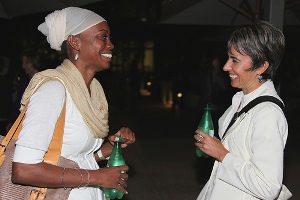 One finding that always makes religious audiences clap, Putnam said, was that religious people tend to be better citizens than their non-religious counterparts. They volunteer more and donate more – even for secular causes. “I don’t want to say they’re nicer, but they’re better neighbors,” Putnam said. But, he noted in Q&A, young people who were in school during 9/11 tend to be more engaged than previous generations of young people, at least among the upper middle class (working class kids are more distrusting than previous generations). “The most obvious and most plausible reason is that ‘Bowling Alone’ was published in 2000,” Putnam joked. “There could be other explanations. The most likely one is 9/11. That is where the Obama wave came from.”
One finding that always makes religious audiences clap, Putnam said, was that religious people tend to be better citizens than their non-religious counterparts. They volunteer more and donate more – even for secular causes. “I don’t want to say they’re nicer, but they’re better neighbors,” Putnam said. But, he noted in Q&A, young people who were in school during 9/11 tend to be more engaged than previous generations of young people, at least among the upper middle class (working class kids are more distrusting than previous generations). “The most obvious and most plausible reason is that ‘Bowling Alone’ was published in 2000,” Putnam joked. “There could be other explanations. The most likely one is 9/11. That is where the Obama wave came from.”
But the reason for more civic engagement has less to do with religion than one might expect. Theological beliefs have little to do with community involvement. Rather, the more friends one has at church, the “nicer” one is. As Putnam explained, if a nonbeliever goes to church because his wife is religious, and he has friends in church, he’s more likely to engage in his community than a deeply devout believer who prays alone.
“The last book I wrote said that bowling in leagues is better than bowling alone,” Putnam said. “This book says that bowling in church leagues is really good.”
Watch the video here.
See more photos here.
Read an excerpt from American Grace here.
Read In The Green Room Q&As with Bill Parent and Robert Putnam.
Buy the book here.
Read five other experts on religion discussing faith and community here.
*Photos by Aaron Salcido.




Send A Letter To the Editors